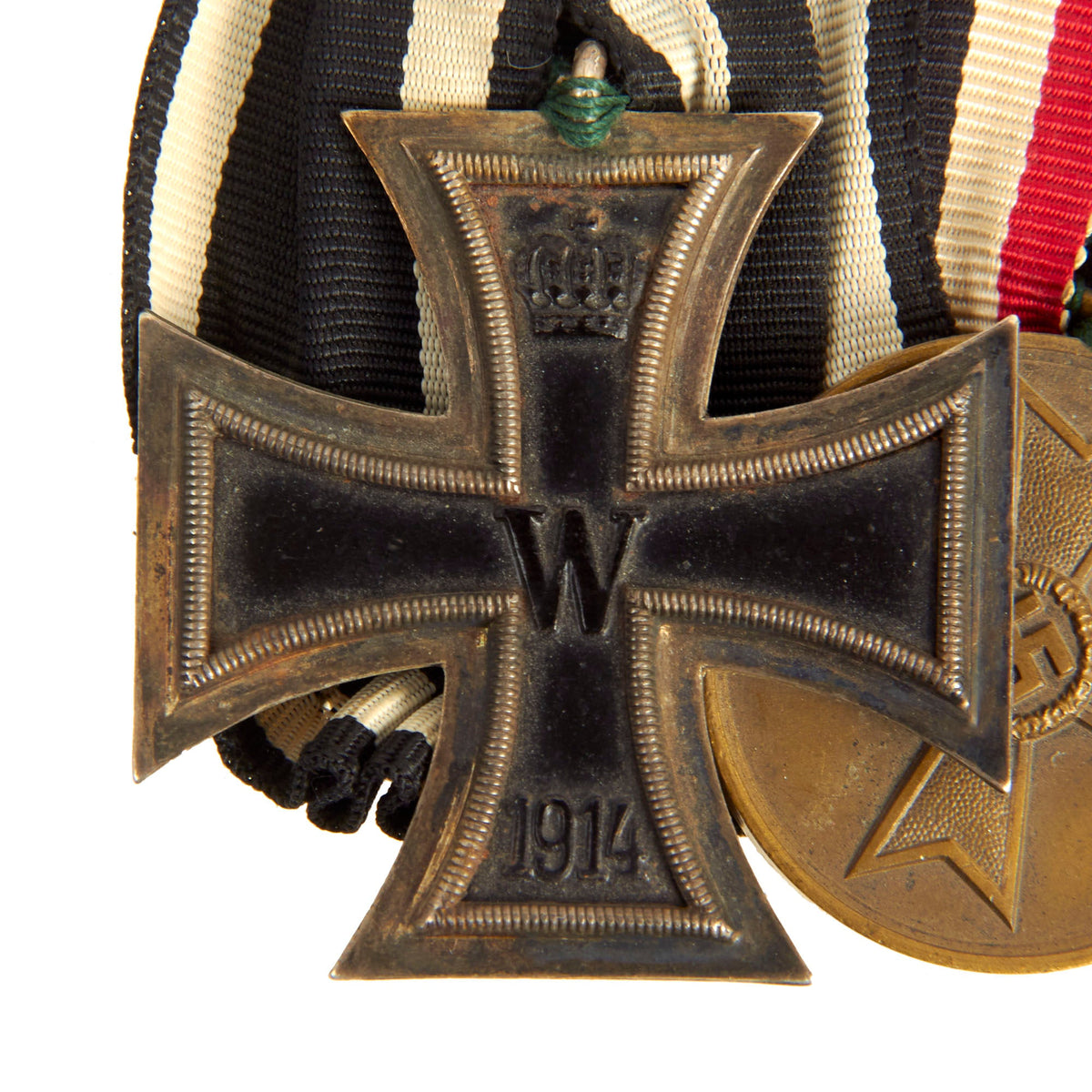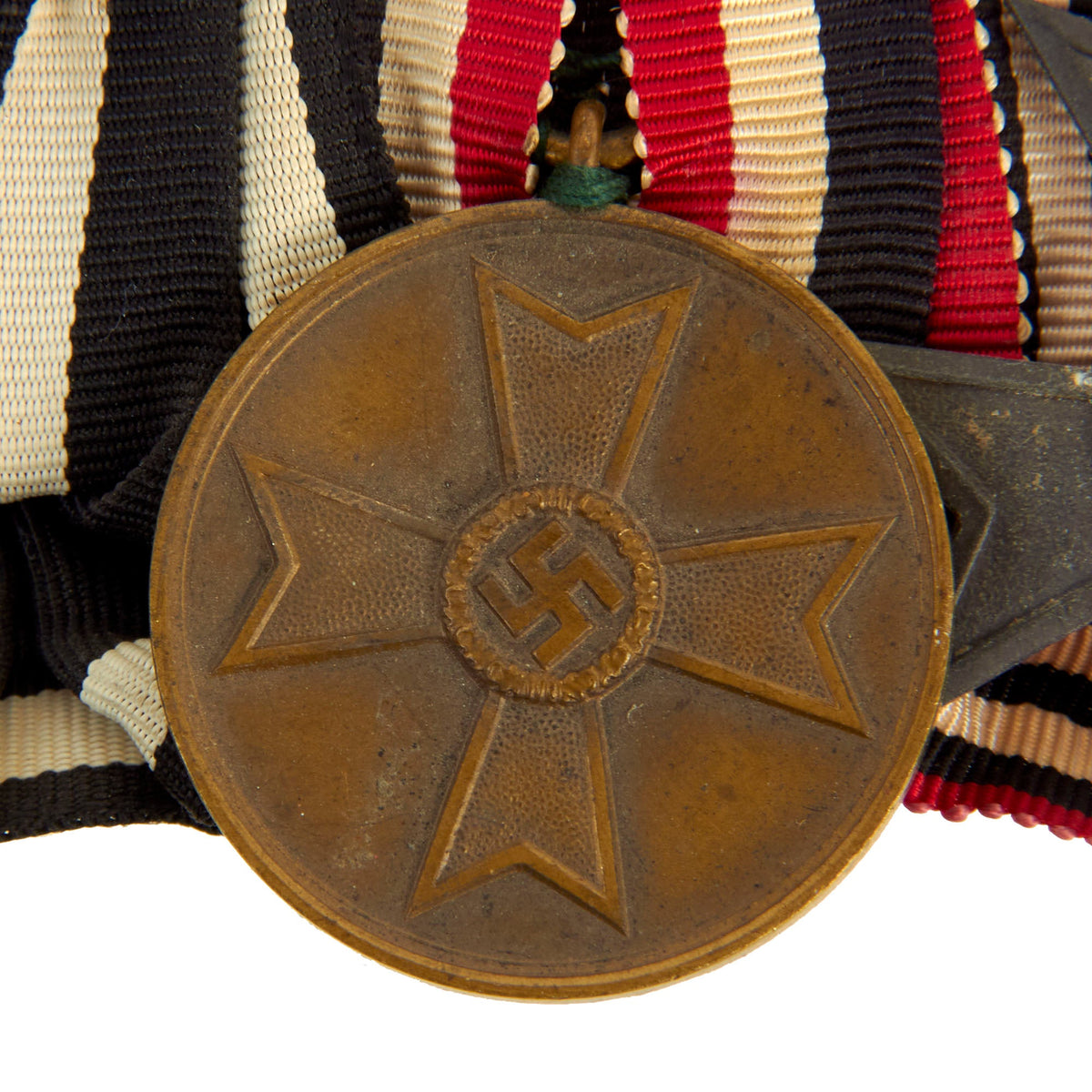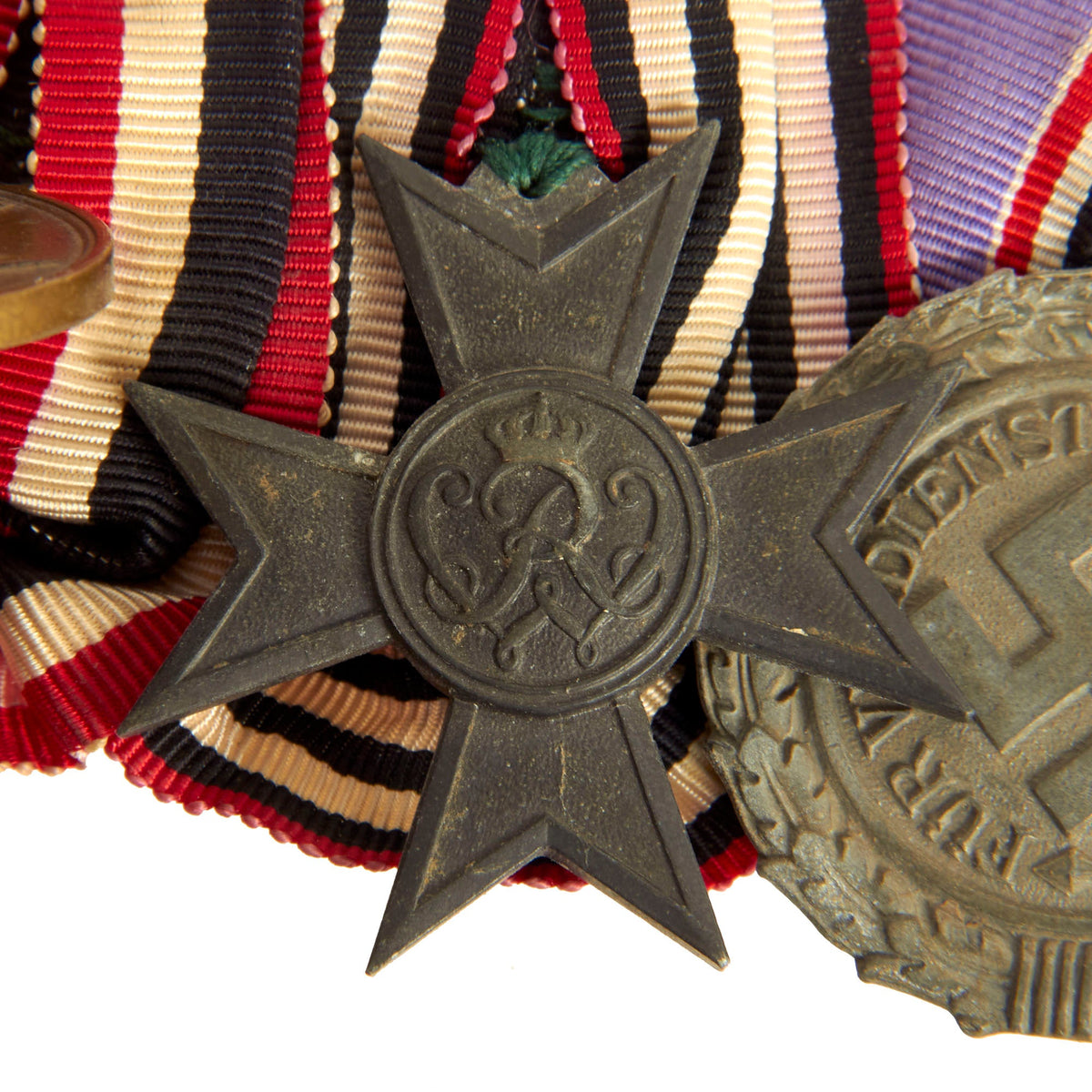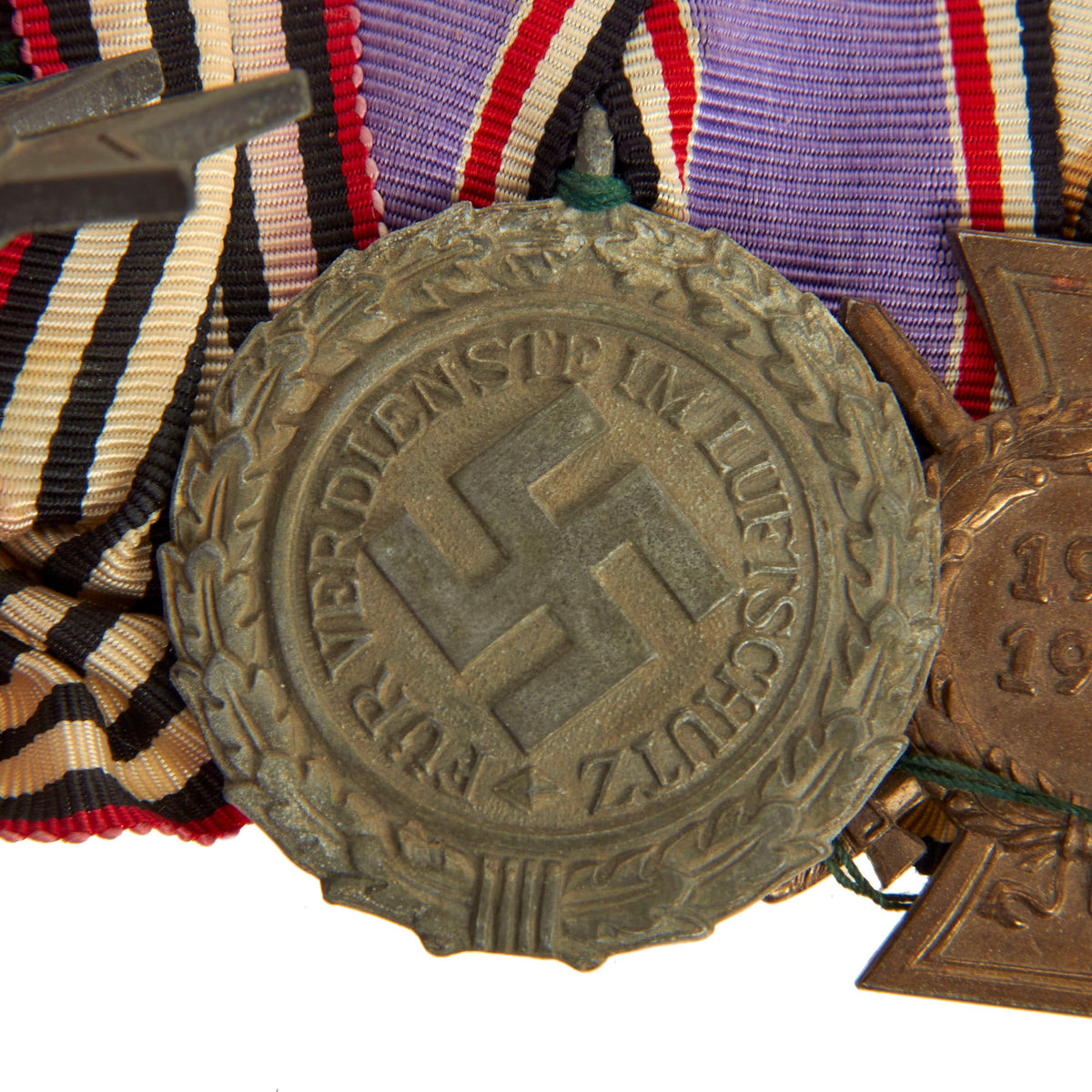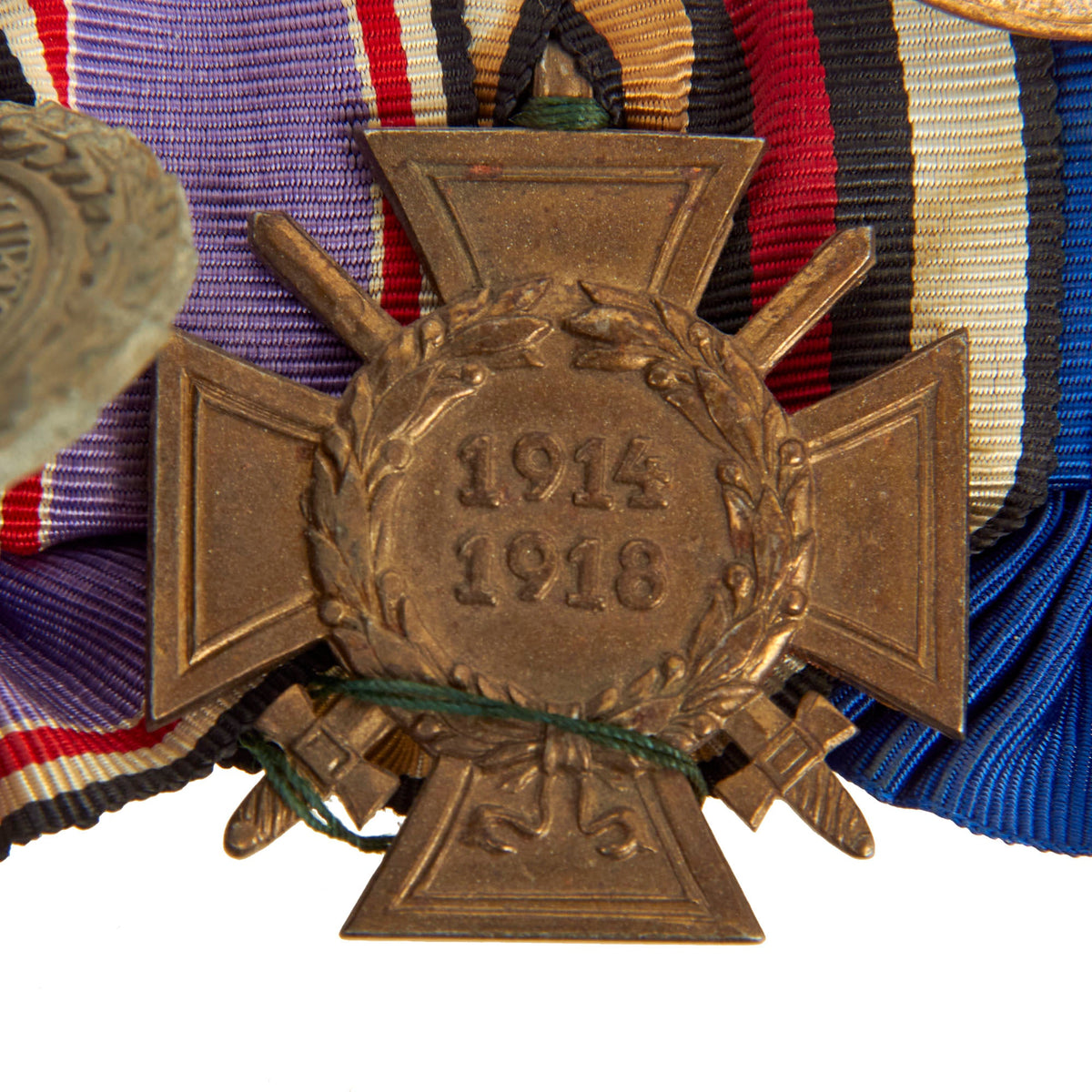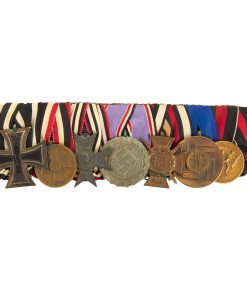Original German WWI & WWII Era Medal Bar with EKII, SS Eight Year Long Service Award & Hindenburg Cross – 7 Awards Original Items
$ 1.995,00 $ 498,75
Original Item: One-of-a-kind. This is a fantastic genuine medal set, which we assume was owned by a German soldier who fought during WWI, and then later served during WWII, joining the infamous SS Schutzstaffel paramilitary organization as well as the Luftschutz Air Raid protection service.
The set of 7 medals offered in good condition is mounted on a very nice gray/brown felt-backed medal bar, which has a long brass securing pin. The colors are well retained, with some light staining and overall oxidation on the various awards.
It consists of the following medals with Ribbons:
– Imperial German WWI Iron Cross 1914 2nd Class Medal (Eisernes Kreuz 2. Klasse, or EKII).
– German WWII 1939 War Merit Medal (Kriegsverdienstmedaille).
– Imperial German WWI Merit Cross for War Aid (Prussian)
– German WWII RLB Luftschutz Air Defense Honor Medal 2nd Grade
– German WWI Honor Cross of the World War 1914/1918 (Hindenburg Cross) Medal with Swords (For Combat)
– German WWII SS Eight Year Long Service Award Medal – SS-Dienstauszeichnungen
– WWII 1 October 1938 Commemorative Sudetenland Medal (Czech Conquest)
Below is an explanation of each medal in detail:
German WWI Prussian Iron Cross 2nd Class with Ribbon:
Established by Frederick William in 1813 for gallantry in action, the Eisernes Kreuz (EK) decoration was revived several times for later conflicts. The bulk of the issues are divided into 1st and 2nd class versions, but a rare and superior ‘Grand Cross’ was also awarded for successful field commanders. During WW1 the lower decoration was freely awarded with 5½ million second class types issued. Originally, the Iron Cross was an award of the Kingdom of Prussia, however given Prussia’s pre-eminent place in the German Empire formed in 1871, it became an award for all of Germany.
The basic design of the WW1 crosses is a central cross patee struck from iron and mounted in a silver frame which has a raised crenulated decorative border. The obverse of the cross bears the date 1914 under a crowned ‘W’ monogram. Reverse bears an oak leaf cluster with the date of the decoration’s institution, 1813 underneath – the crowned initials of Frederick William are in the top arm above the oak leaf cluster. Suspension for second-class types is by means of a ring, and frequently this ring bears a maker’s stamp.
Please examine the edge seam for authentication, which is not present on reproductions. Iron crosses were commonly constructed from an iron core sandwiched in a surrounding two part silver frame, normally the seam of these two silver parts is visible around the edge of the cross as is seen on this fine example.
The War Merit Medal (Kriegsverdienstmedaille) was a World War II German military decoration awarded to recognize outstanding service by civilians in relation to the war effort. It was instituted on 19 August 1940 and usually awarded to those workers in factories who significantly exceeded work quotas. The War Merit Medal was awarded only to Germans and non-Germans civilians, to men and women. An estimated 4.9 million medals were awarded by the end of the war in Europe. It was closely related to the War Merit Cross, which could be awarded to military personnel and civilians alike for outstanding service to the war effort.
The medal was designed by Professor Richard Klein of Munich. It was a circular bronze award bearing the design of the War Merit Cross on the front (obverse), and the inscription “For War Merit 1939” (Für Kriegsverdienst 1939) on the reverse side. It was suspended from a ribbon colored similar to the War Merit Cross, except for a thin red vertical strip added to the center of the black portion. When worn, it was either as a medal ribbon bar above the left breast pocket (soldiers who had earned the medal as civilians could wear it on their uniform), or with the ribbon only through the second buttonhole of a jacket. Since this was a non-combat award, the medal never incorporated swords. After 15 May, 1943, the award of this medal to foreigners was superseded by the Medal of Merit of the Order of the German Eagle.
The Merit Cross for War Aid (German: Verdienstkreuz für Kriegshilfe) was a war decoration of Prussia awarded during World War I. Instituted 5 December 1916, the cross was awarded for patriotic war aid service, without regard to status or rank. The award is in the shape of a Maltese cross, typically found made of blackened Kriegsmetall alloy. The obverse of the cross bears a circular central medallion with the crowned cipher of King Wilhelm II. On the reverse the central medallion is inscribed FÜR KRIEGS-HILFSDIENST (For War Aid Merit) above an oak wreath. To the upper arm is attached a loop for suspension from its ribbon.
German WWII Air Defense Honor Badge 2nd Grade (Luftschutz Ehrenzeichen zweiter Stufe). The 2nd grade Luftschutz medal was awarded for those who gave meritorious service to the civil air defense of Germany from January 1933 onward. It is constructed out of a die struck aluminum-alloy base that has been silver washed. The obverse features a centrally placed mobile swas in a pebbled field, which is surrounded by FÜR VERDIENSTE IM LUFTSCHUTZ (For Merit in Air Defense). The reverse is marked 1938, also in a pebbled field.
Both sides are surrounded by an oak leaf wreath that is tied together at the bottom. To the top is an integral loop and an aluminum ring. These are fitted with a lavender, white, red and black rayon ribbon.
Hindenburg Cross with Crossed Swords (for combat):
The Honor Cross of the World War 1914/1918 (German: Das Ehrenkreuz des Weltkriegs 1914/1918), commonly, but incorrectly, known as the Hindenburg Cross was established by Field Marshal Paul von Hindenburg, President of the German Republic, by an order dated 13 July 1934, to commemorate the distinguished deeds of the German people during the First World War. This was Germany’s first official service medal for soldiers of Imperial Germany who had taken part in the war, and where they had since died it was also awarded to their surviving next-of-kin. Shortly after its issuance, the government of NSDAP Germany declared the award as the only official service decoration of the First World War and further forbid the continued wearing of German Free Corps awards on any military or paramilitary uniform of a state or NSDAP Party organization.
SS Long Service Awards (German: SS-Dienstauszeichnungen) were given in grades of four years, eight years, twelve years, and twenty-five years. The four and eight-year service awards were in the form of circular medals while the 12 and 25-year service awards were in the form of swass. The SS service awards were designed in Munich by Professor Karl Diebitsch. The awards varied in design depending on the length of service of the recipient. According to historian Chris Ailsby the awards ceased to be given at the end of 1941.
It was first introduced by Adolf AH on 30 January 1938, On its reverse side, each award had emblazoned the inscription, in German: FÜR TREUE DIENSTE IN DER ᛋᛋ (“For Loyal Service in the SS”). The medal was awarded to SS members in the SS-Verfügungstruppe, SS-Totenkopfverbände and the SS-Junkerschule who served honorably and were on active service.
The four-year and eight-year awards were the most common awards. Despite the fact that the whole NSDAP movement lasted for little over 25 years (1919-1945) and the SS were founded only in 1925, awards of the 25-year version were made well before 25 years of actual service were completed. This was because the period between 1925 and 1933 (what the NSDAPs termed Kampfzeit (“Time of Struggle”) counted double, and any service in the Armed Forces in the First World War and afterwards, as well as the Police, was also included. Nevertheless, it was one of the rarer awards given out by NSDAP Germany.
1 October 1938 Commemorative Medal
(German: Die Medaille zur Erinnerung an den 1. Oktober 1938) Commonly known as the Sudetenland Medal, this was a decoration of NSDAP Germany awarded in the interwar period. Instituted on 18 October 1938, the medal was awarded to German military personnel who participated in the occupation of Sudetenland and the occupation of Czechoslovakia in March 1939.
The medal was awarded to all German (and as well Sudeten) State officials and members of the German Wehrmacht and SS who marched into Sudetenland. Later it was awarded to military personnel participating in the occupation of the remnants of Czechoslovakia on 15 March 1939. It was awarded until 31 December 1940. In all 1,162,617 medals and 134,563 bars were awarded.
The medal was similar in appearance as the Anschluss Medal, the reverse only differed in the date. It was designed by Professor Richard Klein.
Fast Shipping with Professional Packaging
Thanks to our longstanding association with UPS FedEx DHL, and other major international carriers, we are able to provide a range of shipping options. Our warehouse staff is expertly trained and will wrap your products according to our exact and precise specifications. Prior to shipping, your goods will be thoroughly examined and securely secured. We ship to thousands clients each day across multiple countries. This shows how we're dedicated to be the largest retailer on the internet. Warehouses and distribution centres can be located throughout Europe as well as the USA.
Note: Orders with more than one item will be assigned a processing date depending on the item.
Before shipping before shipping, we'll conduct a thorough inspection of the items you have ordered. Today, the majority of orders will be delivered within 48 hours. The delivery time will be between 3-7 days.
Returns
The stock is dynamic and we cannot completely manage it because multiple stakeholders are involved, including our factory and warehouse. So the actual stock may alter at any time. It's possible that you may not receive your order once the order has been made.
Our policy is valid for a period of 30 days. If you don't receive the product within 30 days, we are not able to issue a refund or an exchange.
You can only return an item if it is unused and in the same state as the day you received it. You must have the item in its original packaging.
Related products
Uncategorized
Uncategorized
Australian WWII Owen MK1 Machine Carbine SMG Custom Fabricated Replica with Sling Original Items
Uncategorized
Uncategorized
Uncategorized
Band of Brothers ORIGINAL GERMAN WWII Le. F.H. 18 10.5cm ARTILLERY PIECE Original Items
Uncategorized
Uncategorized
Armored Burgonet Helmet & Polearm from Scottish Castle Leith Hall Circa 1700 Original Items
Uncategorized
Uncategorized
Uncategorized
Uncategorized
Uncategorized
Uncategorized
Angolan Rebel 1970s era 60mm Inert Display Mortar from Angolan Civil War Original Items
Uncategorized
Uncategorized
Uncategorized
Uncategorized
Uncategorized

